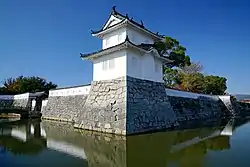Akō Domain
The Akō Domain (赤穂藩, Akō Han) was a domain in feudal Japan. It was located in Harima Province and coincided with the present-day cities of Akō and Aioi and the town of Kamigōri in Hyōgo Prefecture. The domain had its headquarters at Akō Castle.
| Akō Domain 赤穂藩 | |
|---|---|
| Domain of Japan | |
| 1615–1871 | |
| Capital | Akō Castle |
| • Type | Daimyō |
| Historical era | Edo period |
• Established | 1615 |
• Disestablished | 1871 |
| Today part of | Hyogo Prefecture |

In 1615, the Tokugawa shogunate granted the Akō domain to Ikeda Masatsuna. He died without heir in 1631, and the domain passed to his brother Teruoki. However, Teruoki became deranged, and in 1645 he was dismissed; the domain was ruled by the main line of the Ikeda family until the appointment of Asano Naganao later that year. Under the Asano, the domain reached its highest rating of 53,000 koku.
Naganao's grandson Naganori was the daimyō of Akō at the time of his attempt to kill Kira Yoshinaka in Edo Castle in 1701. He was sentenced to commit suicide and his retainers became rōnin. A group of them became famous as the Forty-seven rōnin.
The domain passed to Nagai Naohiro, who was transferred elsewhere in 1706. Akō then passed to Mori Naganao. He and his heirs ruled the domain for twelve generations until the abolition of the han system in 1871. The rating of the domain was 20,000 koku.
Lords of Akō - daimyō
- Ikeda clan (35,000 koku, 1615–1645)
- Masatsuna
- Teruoki
- Asano clan (53,000→50,000→53,000 koku, 1645–1701)
- Nagai clan (32,000 koku, 1701–1706)
- Naganao
- Nagataka
- Naganari
- Masafusa
- Tadahiro (r. 1747–1769)
- Tadaoki
- Tadasuke
- Tadaakira
- Tadataka
- Tadanori
- Tadatsune
- Tadanori
References
This article is based on material in the article ja:赤穂藩 in the Japanese Wikipedia, retrieved August 1, 2007. The Japanese Wikipedia cites the following external links:
- 森家の歴史 (History of the Mori Family)
- 江戸時代の赤穂の歴史(兵庫県赤穂市の文化財) (History of Edo-period Akō (Akō City Hyōgo Prefecture Cultural Materials)